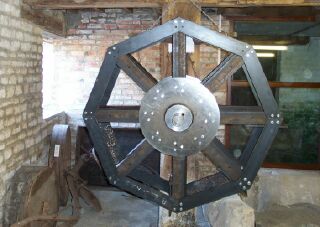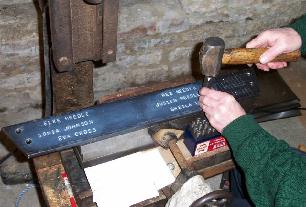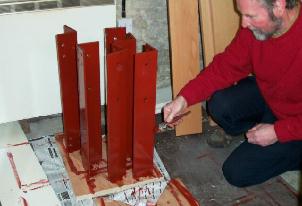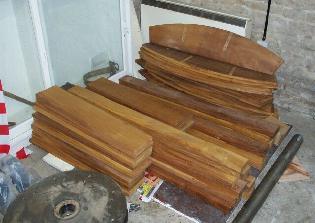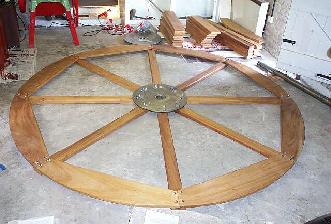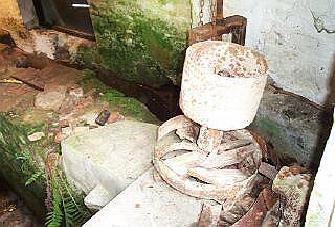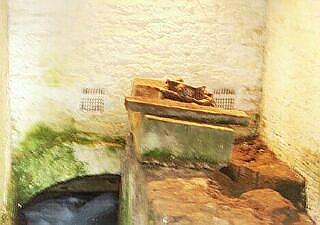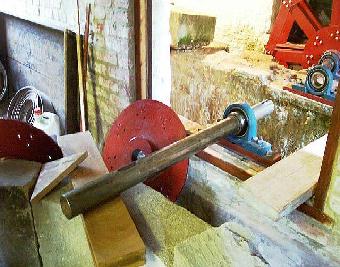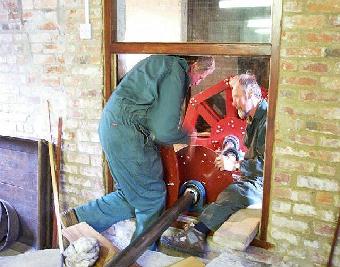|
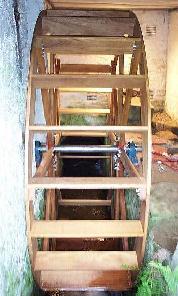
|
THE MILL WHEELS PROJECT
SEPTEMBER 2002 -
SEPTEMBER 2003
under the auspices of
Bourne Civic Society
and Jim Jones M I Plant Eng.
|
THE RESTORATION of the mill wheels is the biggest single project at Baldock's Mill since the building was taken over by the Civic Society in 1983.
The scheme was the brainchild of Jim Jones, a member of the society since
1978 and husband of the chairman Mrs Brenda Jones. "Not only will this project bring the mill to life again but it will also be an added tourist attraction", he said. He undertook the
work after an appraisal of other schemes elsewhere in the country, specifically at Totnes, in Devon, where Jim and Brenda visited a water mill in which the wheel had been rebuilt by a local joiner and wheelwright and the specifications were similar to that which was envisaged at Baldock's Mill. They took particular regard to the materials used, such as seasoned timbers, mild steel and others, which fitted perfectly with the scheme in hand.
The project is costing £12,000 and funded mainly through grants, with £3,500 already being handed over by Lincolnshire County Council. This has enabled the Civic Society to start drawing up plans for the construction and installation of the wheels to bring the building back into its original state when it was used for milling corn.
During its working life, the mill wheel was 15 feet in diameter by 3 feet wide and the smaller flywheel measured 5 feet by 12 inches. It is these two wheels that are to be restored. Jim drew up working diagrams during the summer of 2002, using his past experience as an engineering draughtsman, showing a large wheel made of hardwood, 10 feet in diameter by 35 inches in width, smaller than the original, although this will be largely decorative, and a second wheel made of steel to the original size of 5 feet in diameter and 12 inches wide, and it is hoped that this will harness the water power in the
mill race to generate electricity for use within the building.
|

|

|
|
Jim Jones studies his first draft of the plans (left) and in October 2002, the steel parts
for the small wheel arrive at the mill (right and below).
|
The large wheel will be 5 feet smaller than the original because extensive repairs took place at the mill 20 years ago to strengthen the building and make it suitable for pubic use and these specifications cannot be changed. This wheel will slowly turn to simulate the action of past years.
The paddles on the wheels will be a reasonably close tolerance to the walls of the millrace to harness as much water power as possible. The small wheel will drive a multiplier gear box and in turn, drive a generator, producing a small amount of electricity to supply four storage heaters in the building which currently contribute the main burden of the mill's £300 a quarter electricity bill and so this will be a "green" bonus for the project. This wheel will be connected to a separate circuit to isolate it from the mains, thus enabling the society to keep track of the power and savings generated.
Large plate glass viewing windows already in situ will enable visitors see the wheels in action.

Listed building consent for the project was granted by South Kesteven District Council on 21st October 2002 and Bourne United Charities gave their approval to the scheme two days later.
The first consignment of 58 steel parts arrived in October from Jude Engineering works at Corby in Northamptonshire where they had been specially made for the job to his specifications. The wood sections are being made by Watson Joinery at Thurlby, near Bourne, and accessories by local firms who were vetted for reliability and cost. Jim immediately began assembling the small mill wheel, which has sufficient space on the struts for names to be engraved on them in return for a donation to the Heritage Centre, £5 from members and £10 from non-members, and what better way to perpetuate your presence on this earth than to have it turning permanently inside the mill and at the same time, help one of our town's good causes?
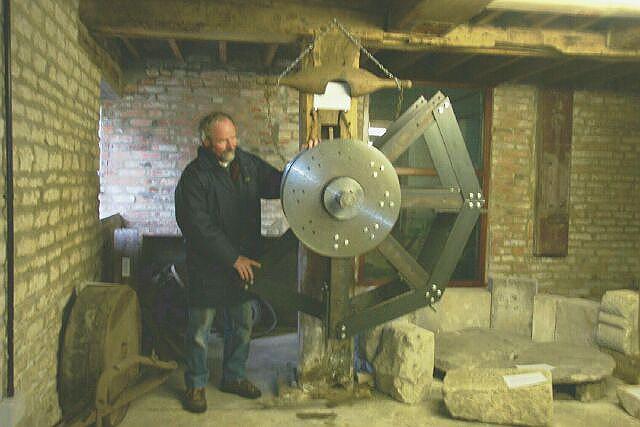
Engineer Jim Jones with the small wheel during an early
test assembly
In the autumn of 2002, a second application for a charity grant to assist with the work was made to Lincolnshire County Council to help finance the ongoing voluntary work. In a progress report to members, society secretary Robert Kitchener said: "The first grant has enabled us to approach the architect, finalise the plans, assess the materials and face the challenge of raising the 40% of the cost locally which is required by the grant. We needed to find the skilled craftsmen to be involved and a heavy gang is standing by. A timetable is essential but we already have a delay because the water level is too high at the moment."
The project was now beginning to take shape and at the end of December, Jim Jones made a test assembly of the steel parts in the mill when the finished product could clearly be seen.
By January 2003, many people had submitted their names to be engraved on the
small wheel and Jim began the work of embossing them on the steel struts. There were 16
in all, each with room for six names and so there was space for a total of 96 names, a massive task because the embossing could only be done by hand and was therefore a slow and arduous process, each name taking between ten and fifteen minutes to complete.
Nevertheless, the demand for space was brisk and by the end of March a total of 100 names had been added and others were still being submitted for inclusion. The project was given some prominence on the Internet through the Bourne web site under the title "Leave Your Name for Posterity" and this resulted in several replies, including one from Vancouver Island in Canada asking for the names of two old families from the town, Redshaw and Brake, to be included. So many names were now being submitted that more space had to be found and it was decided that both sides of the wheel and of the struts would be used and this considerably increased the area available and therefore the number of names that could be included. Meanwhile, essential work on covering the steel sections with a red lead paint was also underway to reduce corrosion on the wheel once it was in place over the mill race.
Early in April 2003, the second wheel arrived from Watson Joinery at Thurlby, delivered by van in 50 sections, struts, paddles and supports, all finished in iroko wood. Iroko is a light coloured hardwood from Africa that had been chosen for the project for its strength and durability and all of the sections had been specially varnished to repel moisture.
The first task was to assemble the various parts, rather like a giant jigsaw, to ensure that they were accurate and the wheel was complete, and this was done in the ground floor of the mill which was out of bounds to visitors as a safety precaution while the work proceeded. Society secretary Robert Kitchener reported in his monthly newsletter: "The preparation for fitting both wheels will begin soon. It is too early to name a date for completion except that it will be this summer. The water levels along the Bourne Eau have been high which bodes well for when the wheels are in place, but this will be a disadvantage during assembly."
A side section of the larger, wooden wheel was eventually assembled to ensure that it had been made to specifications and that the sections fitted but its sheer size of 10 feet in diameter made this a difficult task in the confined space available. Nevertheless, by Wednesday 23rd April, the work was completed and for the first time it was possible to see what the second wheel would look like.
The wheel with the first set of names engraved on the struts. Demand was so
great that additional space had to be found to include every one.
In May 2003, work began on preparing the structure around the mill race to take the two replica wheels but close inspection revealed that the task would be long and arduous. The first job was to remove the old axle and spindle, now corroded with age but still difficult to remove although this was eventually accomplished by hand. The second obstacle was a pillar block, a large rectangular shaped stone that had formerly been used to keep the original wheels in place. This was now redundant and had to be moved because it was causing an obstruction but it weighed around 3 cwt. and after Jim Jones and society member Jonathan Smith spent several unsuccessful hours working in cramped conditions to shift it, they decided that expert help was needed.
They called in newly-elected committee member John Scholes, a railway enthusiast with his own railway station, track and engine at Rippingale, and who therefore had a wide variety of heavy duty equipment at his disposal and he eventually arrived with the necessary rollers and bar which made light work of the job and the stone was moved to safety on the parapet at the end of the mill race.
The Environment Agency visited the mill at the end of May to survey work in progress and their representative praised the standards that were being achieved and offered encouragement.
In June 2003, secretary Robert Kitchener told members in his monthly newsletter: "Jim Jones has been digging out undergrowth and debris form the mill race and relocating the wheel mountings. Steady progress is being maintained to this very challenging project. It is hoped to have a target completion date in our next issue."
Meanwhile, the physical work of installing the moorings for the two wheels continued and this involved removing the viewing window overlooking the mill race, a delicate task to avoid cracking or chipping the glass, but this was achieved successfully on June 11th and enabled Jim secure them in concrete in readiness for the final installation of the wheels. These tasks were not without their hazards as Jim discovered. While crouched over the wheel mountings, his glasses slipped off and dropped into the mill race and he climbed down to retrieve them but the force of the water washed them into the main pipe and that was the last he saw of them. He bought a replacement pair but this time took the precaution of also purchasing a cord to secure them round his neck while he worked and so prevent a recurrence of the mishap. "It can be an expensive business if you don't take care", he said wryly.
More heavy lifting work was needed when the hubs and roller bearing housing for the small wheel were hauled into position.
| The components weighed over 2 cwt. but in the absence of heavy lifting gear, the task was completed on a Saturday morning by Jim and John Scholes, with some able assistance from Jim's wife Brenda, although this was certainly no task for a lady. This provided the basis for the assembly of the wheel and a few days later, Jim began adding the struts and paddles, although some unexpected remedial work was required to ensure that the wheel would clear the wall in the mill race and this necessitated slicing small sections off each of the eight paddles, a painstaking job that held up the assembly for a day but a worthwhile operation to give the wheel a free and unfettered turn. |
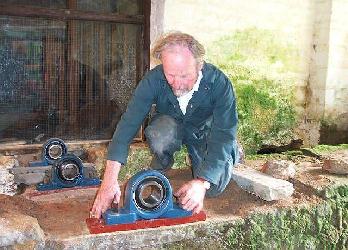
|
For the first time since the project began, it was possible to see what was being achieved and Brenda talked optimistically about a finishing date in time for Heritage Week in September. A week later, the wheel had begun to take on its traditional shape as the struts and spars were added. While this work was in progress, the sluice gate feeding the mill race had been closed although there was a constant flow of water seeping through into the inside channel but this did not affect the task in hand.
By Wednesday, 25th June, the small wheel was almost assembled and ready for the paddles to be fixed into place although it was still clear of the water. Jim also gave the wheel a few experimental turns to test the balance and it revolved perfectly without hindrance. He then took advantage of the fine weather to put in a spot of work on clearing the debris from the Bourne Eau that had piled up against the grill to stop it from clogging up the mill race. Everything had to be perfect when the small wheel began to turn under water power for the first time in almost 80 years.
A heat wave hit Bourne during mid-July in 2003 and this coincided with a busy time for the project but fortunately the mill lived up to its reputation as the coolest place in town. The paddles for the small wheel were now almost ready for fitting, having been made from two lengths of discarded 1" pine shelving which had been found abandoned in the mill from which Jim cut eight sections 11½" wide and 8½" deep and then coated them with red lead paint. Wood was chosen for the paddles because it was a more durable material for this purpose and easier to replace in the event of wear or damage. These were then fitted into place between the
spokes. Preparations were also well advanced for the installation of the larger wheel and on Tuesday 15th July, Jim took delivery of a motor gear box unit that had been made by Pujol Transmission Ltd of Roman Bank, Bourne, at a cost of £600.
It weighed 2 cwt. and although Jim had help in loading it into the back of his car at the factory, on returning to the mill he had to wait for the arrival of Civic Society members for a meeting that evening to recruit volunteers to manhandle it into the building.
This 250 volt chain driven unit with an output of 15 revolutions a minute was designed to give added power to the big wheel which has less water flow from the mill race than the smaller one and it also contains a slot to take 50p or £1 coins which can be fed in by visitors to turn the motor and see the wheel in action. The idea for this came from the Museum of Science and Industry in Manchester where there is a working water wheel on display powered by a similar device that was spotted by Jim and Brenda during a visit in the summer of 2002 while in the city for the Commonwealth Games.
Fitting the main shaft into the moorings for the large wheel was heavy duty work and after committee member John Scholes offered to help, the job was completed on the evening of Friday 18th July when the two outside bosses were also keyed into place on the shaft ready to take the struts that would support the paddles.
It was now time to begin the assembly of the larger wheel from the 50 wooden sections that had been delivered four months before. This entailed sorting them out into a sequence ready for bolting on to the two outside bosses and Jim began the work on the afternoon of Wednesday 23rd July with Brenda as his helper, fetching and carrying and holding the larger sections in position until they were secured. The task went so well that by late afternoon, the job was 75% complete and they decided to continue into the evening and by the time they went home at 7 pm, only the paddles remained to be fitted. This was one of the more rewarding parts of the project because when they left the mill, it was now possible to envisage how the wheels would look over the mill race.
The project had been going so well that a set back was inevitable and this came when Jim noticed that the water flow in the mill race underneath the small wheel was not as strong as he would have wished. Power was being lost and a test of the depth revealed the cause: there was a large hole some two feet deep in the bottom that was reducing the flow of water needed to turn the wheel. He pondered over a solution for some days and then decided that the cavity would have to be filled in to regain the required force, with bricks, rubble, rocks, gravel or perhaps even a special cement. It was a problem that required some thought.
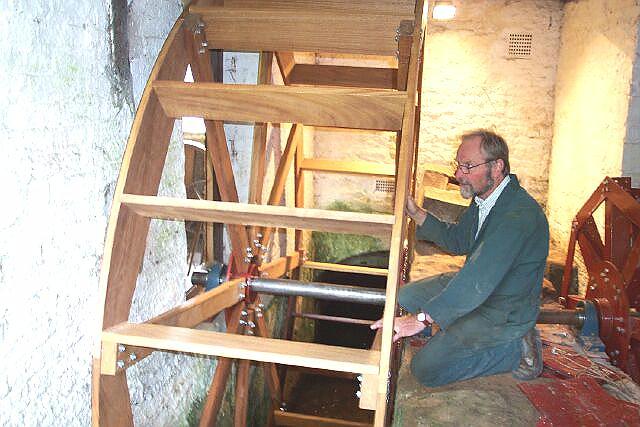
Meanwhile, there was another worry when Jim arrived at the mill on Thursday 24th July to find that a number of ducks had been sucked through the grill from the mill pool and into the race of the larger wheel where they were trapped and unable to get out. He counted two adult female mallard and five ducklings, all in an agitated state, flying to and fro and attacking each other, but unable to regain the river and there was no way that they could be reached and rescued. Jim was forced to leave them there when he closed the mill that night, hoping that they would manage to navigate their way through the pipe which takes the Bourne Eau underneath South Street, for this is the only way they would be saved.
This must have happened because when he arrived at the mill next day, all of the ducks had gone and they were later reported to be swimming happily in the river alongside Church Walk.
The official opening date for the project had now been fixed for Saturday 13th September. A two-week holiday from work from July 28th enabled Jim devote his energies entirely to completing the bulk of the work in hand and so leave sufficient time for testing the two wheels and solving the many minor problems that he had encountered. By next day, all of the 24 paddles had been bolted securely to the outside supports of the large wheel and it was now resembling what it was intended to be.
| The large wheel could now be seen much as it was in the mill's working days. The various types of watermills can be identified by the position at which the water strikes the paddles, either overshot or undershot. Overshot wheels in which the water strikes the top first can usually be found on man-made or natural weirs and are the more expensive but also the more efficient of the two, needing only a quarter of the volume of water to produce the same amount of power. Baldock's Mill had an undershot wheel which was turned by water flowing through the vanes at the bottom, as can be seen with the restored wheel in position over the mill race.
A final test revealed that both wheels were revolving freely. The larger one was clear of the mill race and taking only an occasional splash as it rushed by underneath because it was not designed to be powered by water but by the engine collected from the makers earlier in the month. Nevertheless, it would add that touch of realism needed from a working water mill while the smaller, metal wheel did all of the necessary work. |
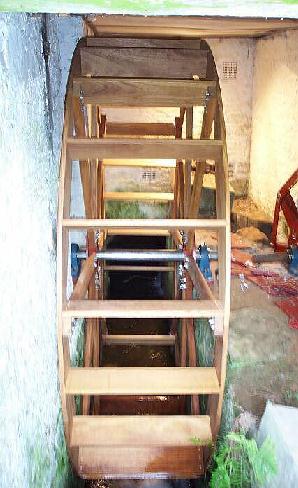
|
The problem with the hole in the floor of the mill race beneath the smaller wheel was solved during the first week in August. Jim tipped in a quantity of gravel and bricks to provide a base and on top of that went six sandbags filled with a special slow drying cement to bring it up to the required level.
The effect was almost instantaneous and the water flow was soon back to the necessary strength required to drive the wheel. But even more power could be produced by making a small adjustment to the eight paddles and so specially-made strips of U-shaped galvanised steel were screwed to each to increase the scoop potential, an idea that worked perfectly.
Work was now going ahead to clear the mill pool of algae that might choke the grill once the sluice gate was opened to allow the full force of the river into the mill race. Civic Society secretary Robert Kitchener, a former seaman, arrived to help with this task for which they borrowed a small rowing boat called St Peter from Bourne United Charities, a craft made in 2002 by pupils of the Robert Manning Technology College, which was used to monitor water levels along the river and keep it clear of weeds and debris.
Meanwhile, a skip was ordered to remove all rubbish that had amassed in and around the mill over the years and Jim gave the railings along the river bank at the back of the building a fresh coat of black paint in readiness for the opening. All of his work was carried out during the heat wave of early August and despite the arduous nature of the task in such conditions, it was rewarding to see the results.
Invitations were sent out to 80 people for the opening of the restoration project on Saturday 13th September. It was hoped that either the society's president, Lady Jane Willoughby, or the town's MP, Mr Quentin Davies, would perform the ceremony, but both were unavailable on that day and so Councillor Peter Bray, chairman of Lincolnshire County Council, was asked to officiate and he accepted.
The installation work was now reaching the final stage and Jim started fitting the engine that would turn the larger of the two wheels. A concrete base was needed on top of the stone wall which separated the mill race where it could be secured and this involved making a wooden template and mixing the cement and this was completed on Friday 23rd August.
Meanwhile, Brenda was busy painting the notice boards that were being prepared for a photographic display of the old building and of progress on the wheels restoration project. Curtains had been ordered to cover the viewing window in readiness for the opening ceremony and catering arrangements for a buffet reception were well in hand.
One of the last tasks was to fit the small engine into the concrete base and install additional lighting within the mill race to ensure that visitors could see the two wheels in detail. In both cases, additional wiring was needed and this involved bringing the electricity cable from the mains box on the first floor through specially drilled holes but this was completed on Wednesday 3rd September, the same day the photographic display was mounted showing pictures of the mill before work began in 1973 and an illustrated chronicle of the wheels restoration project from its inception through to its conclusion.
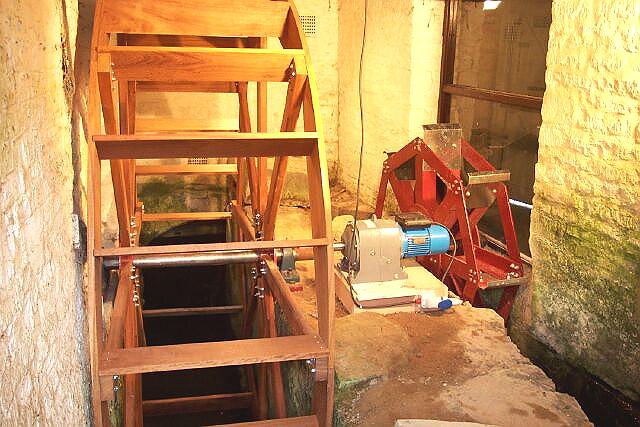
A list of the 149 names engraved on the small wheel was also framed and displayed on the wall adjoining the viewing window together with a photograph of the wheel before it was painted and showing all of the struts on one side containing the inscriptions.
Another problem, however, had now become manifest because the water in the mill pool was more than two feet below the usual level because of the continuing dry spell and there were fears that there would be insufficient to drive the small wheel once the sluice gate was opened to feed the mill race. The first test of the water power was due to take place the following week, just days from the official opening, and Jim looked anxiously at the levels along the Bourne Eau each day, hoping for rain which would alleviate the present parlous situation.
The small engine was finally coupled to the large wheel on Tuesday 9th September and it began turning the moment it was switched on. The speed has been fixed at 10 rpm which simulates the action of the original wheel when the mill was in working order. The water flow in the mill race however
remained a problem and with still no rain and persistently low water levels along the Bourne Eau, it was decided not to open the sluice gate and to proceed with the official opening without the small wheel turning. This was a disappointment but at least, unlike the millers of past centuries, there was no corn to grind.
All was now ready for the opening which was due to take place on Saturday afternoon with more than 70 guests.
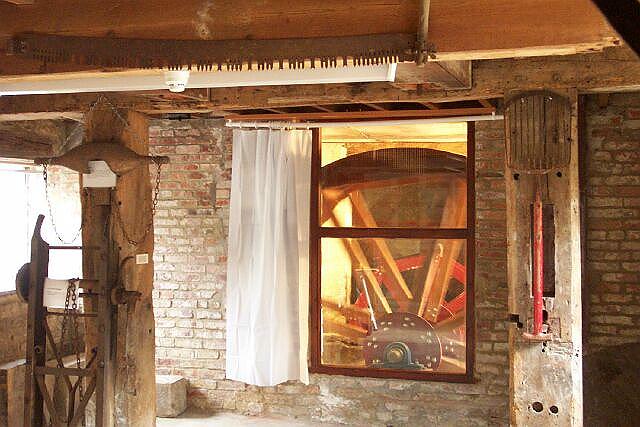
UPDATED SEPTEMBER 2003
A
list of the names engraved on the smaller of the two mill wheels
Producing green electricity
Return to Baldock's
Mill

Go to:
Main Index Villages
Index
|






